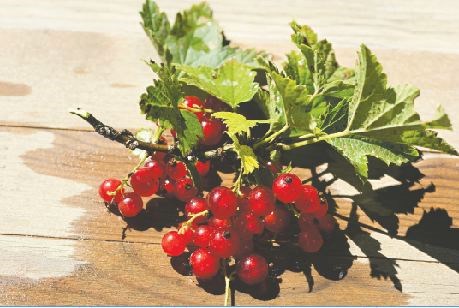Growing your own currants is a great way to have an edible landscape. They are an attractive multi-stemmed, deciduous shrub which gives you the added bonus of edible berries that make great jams, jellies as well as can be eaten fresh or dried. The berries are soft and do not transport well, so growing your own berries is the best way to ensure great tasting berries. Currants have been growing in local gardens very successfully for years as they do best with a cold winter and cooler summer temperatures, which is what our climate offers!
When growing currants, choose a site that receives full sun, but they can tolerate some slight shade during the heat of the day as they do not like intense heat. Some protection from strong winds can also be beneficial. The soil should be moist, well-drained, fertile, and rich in organic material with a pH around 6.5. If you are on a clay soil, a raised bed might be the better method of growing currants. Plant currant bushes, slightly deeper (2-4 cm) than they are in the container. Space the bushes 1.2 meters apart in rows 1.5 meters apart. After the bushes have been planted give them a thorough water. Adding 5 cm of mulch around the plant will help keep the soil cool and moist as well as keep the weeds down. For the best berry production keep the soil moist during the growing season. When giving the plant water, try to avoid getting the foliage wet to avoid fungal problems. Currants are self-pollinating, meaning that you only need one plant to have fruit, however, if you have more than one variety you could experience a higher yield of berries.
There are a few varieties available at the garden centre. These include the red berry varieties such as 'Cherry Red Currant', and 'Wilder', or the black berry varieties such as
'Crandall'.
Once the plants have become established they are easy to care for and do not require a lot of work. Fertilize the plants in the spring with a well-balanced fertilizer and re-apply the mulch. Applying 'Lime Sulphur and Dormant Oil' to the plant before it breaks into leave will kill most overwintering pests and diseases. Annual pruning will help keep the plant healthy, nicely shaped as well as increase fruit production. Remove any dead or diseased branches first. Red Currants bear their fruit on old wood. When pruning a red currant, you want to create a goblet shaped bush. Black currants bear their fruit on last years wood so you want to maintain a few strong, 2 year old canes and several strong, 1 year old canes, and remove the rest at ground level.
Harvest red currants as soon as they are clear in colour. Pick the whole cluster to avoid harming the fruit. Black Currants are harvested individually, as they ripen, before they shrivel and fall off.
Currants and gooseberries are closely related. Gooseberries are pruned similar to red currants.



